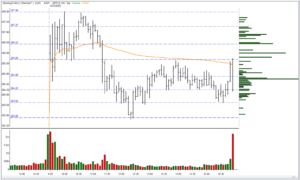Forgotten Profits Trade Setup Archive
Below you'll find Ian's setups stacked up and ordered chronologically. As this service once resided at another home, the alerts only go back to mid July. For a full track record, see the portfolio.How to Use the Volume Weighted Average Price (VWAP) in Day Trading
How to Use VWAP in Day Trading: Strategies and Interpretation
What is VWAP?
VWAP stands for Volume Weighted Average Price. It reflects the average price a security has traded at throughout the day, based on both volume and price. It is recalculated throughout the session and is typically plotted as a single line on a chart.
The formula for VWAP is:
VWAP = (∑ (Price × Volume)) / ∑ Volume
This line helps traders identify whether price is trading at a premium or a discount relative to the session’s average, which can be a proxy for institutional sentiment.
How Day Traders Interpret VWAP
VWAP is not just an average—it’s a battleground. When price is above VWAP, it suggests bullish sentiment and institutions may be supporting the stock. When price is below VWAP, bears are likely in control. Many algorithmic and institutional traders use VWAP as a benchmark to determine whether they’re getting a good deal on their buys or sells.
Common VWAP Interpretations:
- Price Above VWAP: Bullish bias; consider long setups.
- Price Below VWAP: Bearish bias; consider short setups.
- Rejections at VWAP: Powerful signals that can indicate reversals or continuation trades, depending on context.
Day Trading Strategies Using VWAP
1. VWAP Reversion (Fade Trade)
When price moves far from the VWAP and begins to stall, mean reversion traders anticipate a pullback toward the average. This strategy works well in range-bound or fading momentum environments.
- Long Entry: Extended move below VWAP, showing signs of exhaustion (e.g. hammer candle, decreasing volume).
- Short Entry: Extended move above VWAP, followed by reversal signals.
- Exit: VWAP line or recent price congestion zone.
2. VWAP Reclaim Breakout
This strategy focuses on trades where price breaks back above VWAP after trading below it (or vice versa). The reclaim is seen as a shift in sentiment.
- Long Setup: Price breaks above VWAP with volume confirmation, ideally after consolidating under the VWAP.
- Short Setup: Price breaks down below VWAP from above, indicating potential bearish control.
3. VWAP Support and Resistance
This approach treats VWAP like a dynamic support or resistance level. It’s particularly powerful when it aligns with other key levels, such as a prior day close or pivot point.
- Entry: Watch for strong rejections off VWAP with confirming volume and price action.
- Stop Loss: Just beyond the VWAP line to avoid getting caught in whipsaws.
- Targets: Previous intraday highs/lows or the opposite side of the day’s range.
VWAP and Institutional Behavior
Because institutions use VWAP to benchmark trade execution, large funds often avoid making moves that push price too far from VWAP early in the day. Noticing this tendency can help you anticipate reversals or midday consolidations.
Conclusion
VWAP is far more than just a line on your chart—it reflects the session’s volume-weighted consensus. Learning to read price behavior around VWAP gives you a valuable edge in determining trend strength, institutional activity, and where risk/reward becomes favorable for a trade.
Want to dive deeper? Watch a recent TraderInsight recap where we walk through real trades using VWAP live, or explore our Opening Gap Course to see how we use VWAP alongside gap-based setups.
May 22, 2025


May 21, 2025


